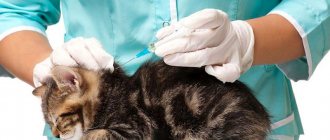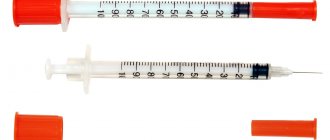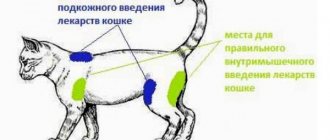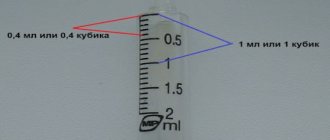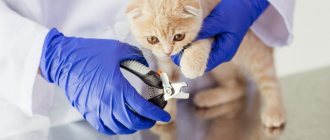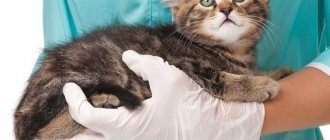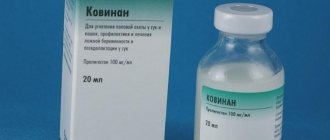Vaccination means the introduction of an animal antigen into the body in order to form immunity to a given infectious disease. Vaccinations for dogs and cats will help significantly reduce the risk of infection and make it easier to transfer the disease if infection does occur.
Note! For subsequent participation in exhibitions and traveling abroad with a pet, it is very important to have a correctly issued and completed veterinary passport.
All information about the vaccinations received by the animal is entered into a veterinary passport issued by a veterinarian. In this case, the following data is indicated: date of vaccination, type of vaccine, registration number in the registration register.
Preparation for the procedure
Do not feed your cat various medications or give injections without consulting a doctor: this can harm your pet’s health. If the veterinarian has prescribed injections, then follow the dosage and follow all instructions.
If you are even a little worried before the procedure, then you will have to relax and calm down, because pets perfectly understand your mood and emotions.
Before you give your furry an injection, you need to prepare:
- Use only sterile disposable syringes. For a dose of less than 1 ml, it is better to take insulin with a short needle.
- Always check the expiration date of the medicine, study the instructions thoroughly, and especially the section indicating the exact dosage.
- First, wash your hands with soap and dry thoroughly with a clean, dry towel.
- Warm the ampoule with your hands to body temperature.
- Take a paper napkin, fold it several times and wrap it around the top of the ampoule.
- Break the ampoule in the direction opposite to the cut.
- Draw the medicine into the syringe; this should be done 5 minutes before the injection.
- Place the injection vertically, tap a little with your nail (so that air bubbles come off the walls) and release the air with a small amount of the drug. Now the injection is completely ready, all that remains is to prepare the cat for the upcoming injection.
Basic rules and recommendations
When self-administering the drug, be sure to follow the rules of personal hygiene:
- before the procedure, wash your hands with soapy water and wipe with alcohol;
- use a disposable syringe, always sterile;
- do not touch the needle with your hand;
- a new sterile needle is required for each injection;
- do not use open ampoules.
Sometimes expensive drugs are intended for several injections. Don't start with a different bottle each time. It is enough to draw the recommended doses into various syringes and close them with plastic caps. Medicines should be kept in the refrigerator; shelf life should be indicated in the instructions for the medicine.
Although it is not always possible to use this method. For example, powdered medications are diluted immediately before the procedure , as they tend to create a sediment. Before use, the ampoules are warmed in your hands. The temperature of the medicine should be slightly higher than the ambient temperature.
Important! You cannot use a clean ampoule whose name has been erased. Check the expiration date of the drug, throw out expired copies.
In open boxes, check the name of the medicine. Since, quite possibly, during cleaning they put a single ampoule in an empty space in the box.
Read the instructions before use; you may need to shake the drug before use.
Prepare a special file for opening the ampoule. Wrap it with cotton wool and press in the opposite direction. Some copies have a mark. Then, insert the needle. For convenience, lift the ampoule upside down and draw the solution. After filling the container, squeeze out the excess air from the syringe with a piston.
Do not try to combine two medications into one device. A negative reaction and sedimentation may occur.
Decide on the type of injection. Not all drugs can be administered intramuscularly or subcutaneously. For example, calcium chloride is administered only intravenously, and diphenhydramine is suitable only for two types of injections: intravenously, intramuscularly. Any discrepancies can lead to tissue death and worsen the situation.
Subcutaneous injection
How to give a subcutaneous injection to a cat, follow all steps in order:
- Place your pet comfortably, for example, on your lap or on the sofa. Examine the withers, it is important that there are no inflammations, wounds or diaper rash on the skin.
- Pull the withers up a little and form a fold with your hand.
- The needle should be held parallel to the back and carefully but firmly insert the syringe into the fold. If you use an “insulin syringe,” then deepen the entire needle; with another type of syringe, only 0.5-0.7 cm.
- If, after piercing the skin, you feel that the needle will fall inward, this is a notification that the needle has successfully pierced. Administer the medicinal solution. Upon completion of the administration of the medicine, remove the needle along the same trajectory.
Step-by-step instruction
There are three types of injections: subcutaneous, intramuscular and intravenous. Injecting medicine into a vein is difficult; specialists do this, so we will only consider the first two types.
Subcutaneous injection
Subcutaneous injections are made into the withers (between the shoulder blades) or into the knee fold. Most often, injections are prescribed at the withers, because it is less painful and there is a lower risk of hurting nerves and blood vessels.
- Place your pet on a flat surface. Give it time to calm down.
- Grasp the cat by the fur, having previously secured the animal, and slightly pull part of the skin. A fold should form.
- While the second person firmly holds the pet's body, insert the needle into the resulting fold. The insertion angle is 45 degrees. Place the needle 1-1.5 cm deep.
- At first you will feel resistance, the needle will enter tightly. As soon as you feel that the resistance has disappeared, it means that you have entered the skin.
- Administer the medicine as directed. Pull out the syringe and release the skin.
- Massage the injection site with your thumb and give your pet a treat.
Intramuscular injection
When giving an intramuscular injection, the most important thing is to choose the right puncture site. Usually they prick in the hind leg, in the middle third of the thigh along its posterior-outer surface. The depth of needle insertion is 1-1.5 cm.
Feel the area above the cat's knee (middle third of the thigh). There you will find a hole in which it is best to inject.
- Secure the cat on a flat surface and massage the injection site. To do this, bend your pet's paw and relax it with a massage.
- Feel the bone and step back from it one and a half to two fingers so that the insertion falls on the posterior outer surface of the thigh. This will indicate the approximate injection site.
- Insert the needle at a 45 degree angle.
- Pull the plunger back slightly. If blood appears, it means you have entered a blood vessel. There is nothing wrong, take out the syringe and insert the needle into another place.
- If there is no blood, administer the medicine. On average, the drug should be administered in 2-3 seconds.
- Pull the needle out and massage the injection site. Give your pet a treat.
Intramuscular injection
How to inject a cat in the thigh:
- Lay the cat on its side, it is best to have someone from your family or friends help you.
- Feel the bone so as not to hit it with a needle.
- There is no need to somehow compress or stretch the corner location.
- The needle should be inserted into the central part of the thigh 1 cm at an angle of 45°; remove the needle in the same projection so as not to cause pain to the cat.
Useful lifehack! If there is no one at home and you do not know how to give a cat an intramuscular injection, then you can calm the cat with a clothespin. Secure it to the withers, the cat will think that someone is holding it, and therefore will not kick and try to escape. They have developed this reflex since childhood, when their mother drags them from place to place.
How to Store Prefilled Syringes
How you store prefilled syringes depends on the type of medicine in them. Most medications are stored at room temperature, but some should be kept in the refrigerator. Your healthcare provider will tell you how to store your syringes. Do not store prefilled syringes in the freezer or leave them in the sun.
Check one of the boxes below so you don't forget how to store your syringes.
- Store prefilled syringes at room temperature.
- Store prefilled syringes in the refrigerator.
If you have questions about storing or carrying prefilled syringes while traveling, contact your healthcare provider.
What to do if the medicine is frozen
If the medicine inside the syringe is frozen, place it near the front of the refrigerator or on a shelf in the refrigerator door to thaw. Do not use the medicine if it has been frozen more than once. Call your healthcare provider for further instructions.
to come back to the beginning
Rate of drug administration
It depends on the volume of the medicine, as well as on its thickness. Aqueous solutions are injected at an average rate of 1 ml per 1 second, and oily or viscous solutions - the same volume in 5-7 seconds.
If all the instructions presented are difficult for you to perceive in text form, then you can watch a video on how to give an injection to a cat.
What diseases are vaccinated against?
According to the vaccination calendar, cats are recommended to be vaccinated according to age against several of the most dangerous diseases.
What diseases is it recommended to vaccinate your cat against?
- Rabies (rabies) is a deadly infectious disease that cannot be cured. Manifests itself with severe symptoms that occur 2-3 days after infection. Infected animals and rodents are carriers of the infection.
- Rhinotracheitis is a herpesvirus infectious disease that affects the respiratory and visual organs. Has an acute course. The carriers of the virus are sick cats. Mortality occurs in 20% of cases.
- Calcivirosis is a common infectious disease of cats, transmitted from other members of the genus who are carriers of the insidious virus. The risk of death is more than 80%.
- Viral peritonitis is an infectious disease caused by coronavirus. Infection occurs through airborne droplets after contact with a carrier of the infection. The risk of death is very high (more than 90% of cats die).
- Panleukopenia is an acute viral disease also known as feline distemper. Sick or already ill cats serve as spreaders of infection. Difficult to treat. Causes critical symptoms. The risk of death is 90%.
- Chlamydia is a contagious feline disease of an infectious nature with a severe and long-term course. The main carriers of infection are birds and rodents. The disease affects the genitourinary, respiratory, visual and digestive systems. There are risks of infecting people.
- Microsporia is a skin disease also known as ringworm. Carriers of infection are sick animals. A cat with microsporia often infects its owner. The most popular drugs for vaccinating cats against various infections: Nobivak, Quadrikat, Multifel-4, Microderm, Leukotsel, Felovax-4, etc. The drug will be selected by the attending veterinarian.
The appearance of abscesses
Swelling and ulcers after injection can only appear if you performed this procedure incorrectly. A dangerous microorganism or bacterium penetrates into a small wound, resulting in an infection, accompanied in most cases by tissue inflammation.
The swelling may go away on its own after some time. If this does not happen, then an abscess forms, they are already removed through surgery, after the operation the veterinarian prescribes a course of anti-inflammatory drugs.
Procedure in a clinic or at home
The injection can be done on an outpatient basis, that is, by arriving at the treatment room at a predetermined time. This option has several objective disadvantages.
- The wait time for an appointment in the corridor outside the treatment nurse's office can be long, but the procedure itself will take about one minute.
- While in line or on the way, a patient with a weakened immune system may contract an infection , which will lead to further complications.
- A patient in need of therapy needs gentle treatment and rest, and a trip to the clinic for a procedure that takes one minute is an unnecessary burden.
- are immobilized due to injury and other reasons , and therefore an intramuscular injection performed at a fixed price at home is the only way to carry out treatment.
It is also not recommended to invite advert “specialists” who offer a reduced price for an intramuscular injection at home, but cannot guarantee safety. At the same time, many private clinics, including “Private Ambulance No. 1”, where experienced doctors work, offer a price list accessible to patients.
Lameness
Limping on the hind leg is common after injection. Most often, this happens after painful injections - antibiotics or thick, oily medications.
Veterinarians assure that there is no need to worry about lameness - most often, pets begin to run on the 2nd day.
But if your Murzik has been limping for 3-4 days, then you need to take action, since this is not a normal phenomenon. In this case, you need to show the cat to the doctor as soon as possible, and he will determine the cause of the lameness and prescribe the appropriate course of treatment.
General rules for vaccinating pets
The vaccination rules for both dogs and cats are the same:
- The animal must be healthy at the time of vaccination.
- 10 days before vaccination, it is necessary to carry out treatment against skin parasites - ticks, fleas, lice, as well as deworming.
- Although your pet will be examined by a veterinarian before vaccination and will make sure he is in excellent health, it is advisable to monitor the animal, its appetite, general condition for 3 days before vaccination, and also measure its temperature at the same time.
Normally, in healthy dogs it is 37-39C, in puppies – no higher than 39.5C, in kittens – from 38.5 to 39.5C, and in adult cats and cats – 38-39.5C.
Remember! If your pet is allergic, notify your veterinarian. It is possible that the animal will be given diphenhydramine before vaccination.
Nervous behavior
It happens that after an injection and similar medical procedures, the cat becomes nervous, does not touch itself, and hides from you at every opportunity. In veterinary practice, this phenomenon is called a psychological attack.
This causes changes in the functioning of the nervous system, resulting in fear of injections, stress when visiting a veterinary clinic or even when seeing a person in a medical uniform.
- In this situation, there is nothing you can do, you can only wait.
- After some time, your pet will return to its original state.
- You can try to cope with this with the help of treats, preferably harmless (fish treats, pieces of dehydrated meat, etc.)
Young cats can be entertained with games or walks to distract them from the psychological attack, unless treatment involves reducing activity.
Additional vaccinations (as needed):
against dermatomycosis (microsporia and trichophytosis) with the Polivak-TM vaccine (Russia), carried out 2 times with an interval of 10 - 14 days, annually,
or the Vakderm vaccine (manufacturer Vetzverotsentr, Russia), done 2 times with an interval of 10 - 14 days, annually.
Regimen for the Nobivac vaccine (Intervet, Netherlands): Nobivac Tricat: against viral rhinotracheitis, calicivirus infection and feline panleukopenia.
Done at the age of 8-12 weeks - the first vaccination. After 3-4 weeks - re-vaccination. It is given together with the Nobivac Rabies rabies vaccine.
Scheme for Leucorifelin (Merial, France):
The first vaccination with Leucorifelin (against panleukopenia, herpesvirus and calicivirus) is at 7-8 weeks.
Revaccination - after 3-4 weeks with the Leucorifelin Quadricat vaccine (against panleukopenia, herpesvirus and calicivirus plus rabies).
Revaccination must be repeated every year.
Scheme for Multifel-4 (Narvak, Russia):
- Multifel-4 is used against panleukopenia, rhinotracheitis, calicivirus and feline chlamydia viruses.
- The first vaccination for a kitten is at 8-12 weeks.
- Repeated after 21-28 days.
- Revaccination - annually
Additional vaccination (if necessary) - in addition to the schemes above.
Polivak-TM (Russia) - vaccine against ringworm.
It is done annually, twice with an interval of two weeks.
Heat
A slight increase in the animal’s body temperature after injection is considered an adequate reaction of the body.
- But if the high temperature persists for more than 3 days, then you need to immediately go to the veterinary clinic.
- Typically, this complication is associated with an allergy to a drug or the development of an inflammatory process.
We hope that this material was useful to you, and now you can give your cat an injection yourself. Good luck!
What complications may there be?
The introduction of medicinal solutions, regardless of the location, injures the surrounding tissues. Complications can arise not only when the procedure is carried out ineptly, but also from an experienced specialist. The most common negative consequences of injections are:
- hematomas – formed due to damage to a blood vessel by a needle and penetration of blood into neighboring tissues; they do not require special treatment and go away on their own;
- blood protruding after removing the needle - just as in the previous case, serves as a sign of damage to the blood vessel; to stop the bleeding, it is enough to apply cold to the wound;
- bump, compaction, swelling at the injection site - can have several reasons, for example: too rapid administration of the medicine, infection entering the wound, individual tissue reaction, and others; if the bump does not go away for a long time, and the cat’s well-being worsens, you need to show your pet to a specialist;
- lameness - can be a consequence of the injection itself, as damage to soft tissues, for example, with severe pain from the solution, or as a result of the needle getting into the sciatic nerve; in the latter case (if the damage persists for longer than 2-3 days and the paw remains motionless), you need to visit a veterinarian;
- deviations in behavior are a normal reaction of an animal that goes away on its own over time; the cat may panic, avoid touching, flinch, and so on;
- an increase in body temperature - more often occurs as a reaction to the injected solution, a manifestation of an allergy, and also if sterility was not maintained during the procedure and an infection got into the wound.
Additional symptoms that you need to pay attention to and consult a doctor: pus from the skin puncture site, painful lumps, refusal to eat, loss of activity, apathy for more than 3 days after the injection.
Photo instructions on how to give an injection to a cat
Vaccinations for cats: pros and cons
Before deciding to vaccinate a domestic cat, the owner can weigh the pros and cons of this procedure.
Benefits of animal immunization:
- The risk of contracting dangerous infections is reduced.
- The immune system is strengthened.
- The risk of infection to people from a sick cat is eliminated.
- After vaccination, the owner does not have to worry about the health of his children and the cat, which often walks outside.
- If the animal does become infected, the disease will be milder and will not cause complications or death.
The disadvantages of vaccinating cats are minor. These include the risks of side effects and complications after vaccination. As a rule, such consequences of animal immunization occur in very rare cases. If you follow all the doctor’s recommendations and select a high-quality vaccine to administer, you can be confident that the preventive procedure is safe for your cat.
Myths and truth about vaccination
The most common myths about vaccinations:
- Domestic cats do not get sick; only purebred pets should be vaccinated against infection. This is wrong. The body of both street and purebred cats is equally susceptible to viral infections.
- If a cat does not go outside, it will not get sick . A pathogenic microorganism can be brought into the room from the outside.
- There is no point in vaccinating a kitten that was not vaccinated at an early age. A veterinarian will prepare a treatment schedule for a pet picked up on the street, and vaccination will help reduce the risk of infection.
- It is expensive. Despite the fact that vaccination has a certain cost, prevention is always cheaper than treatment.
